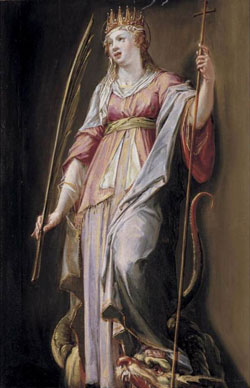
Feastday: July 20
Nothing certain is known of her, but according to her untrustworthy legend, she was the daughter of a pagan priest at Antioch in Pisidia. Also known as Marina, she was converted to Christianity, whereupon she was driven from home by her father. She became a shepherdess and when she spurned the advances of Olybrius, the prefect, who was infatuated with her beauty, he charged her with being a Christian. He had her tortured and then imprisoned, and while she was in prison she had an encounter with the devil in the form of a dragon. According to the legend, he swallowed her, but the cross she carried in her hand so irritated his throat that he was forced to disgorge her (she is patroness of childbirth). The next day, attempts were made to execute her by fire and then by drowning, but she was miraculously saved and converted thousands of spectators witnessing her ordeal-all of whom were promptly executed. Finally, she was beheaded. That she existed and was martyred are probably true; all else is probably fictitious embroidery and added to her story, which was immensely popular in the Middle Ages, spreading from the East all over Western Europe. She is one of the Fourteen Holy Helpers, and hers was one of the voices heard by Joan of Arc. Her feast day is July 20th.
To all our readers, Please don't scroll past this.
Today, we humbly ask you to defend Catholic Online's independence. 98% of our readers don't give; they simply look the other way. If you donate just $5.00, or whatever you can, Catholic Online could keep thriving for years. Most people donate because Catholic Online is useful. If Catholic Online has given you $5.00 worth of knowledge this year, take a minute to donate. Show the volunteers who bring you reliable, Catholic information that their work matters. If you are one of our rare donors, you have our gratitude and we warmly thank you. Help Now > For other uses, see Saint Margaret (disambiguation). "Saint Margaret of Antioch" redirects here. For the painting, see Saint Margaret of Antioch (Zurbarán).Margaret, known as Margaret of Antioch in the West, and as Saint Marina the Great Martyr (Greek: Ἁγία Μαρίνα) in the East, is celebrated as a saint on 20 July in the Western Rite Orthodoxy, Roman Catholic Church and Anglicanism, on 17 July (Julian calendar) by the Eastern Orthodox Church and on Epip 23 and Hathor 23 in the Coptic Orthodox Church of Alexandria.
Said to have been martyred in 304, she was declared apocryphal by Pope Gelasius I in 494, but devotion to her revived in the West with the Crusades.
She was reputed to have promised very powerful indulgences to those who wrote or read her life, or invoked her intercessions; these no doubt helped the spread of her cultus.
Margaret is one of the Fourteen Holy Helpers, and is one of the saints Joan of Arc claimed to have spoken with.
Hagiography
According to the version of the story in Golden Legend, she was a native of Antioch and the daughter of a pagan priest named Aedesius. Her mother having died soon after her birth, Margaret was nursed by a Christian woman five or six leagues (6.9–8.3 miles) from Antioch. Having embraced Christianity and consecrated her virginity to God, Margaret was disowned by her father, adopted by her nurse, and lived in the country keeping sheep with her foster mother (in what is now Turkey). Olybrius, Governor of the Roman Diocese of the East, asked to marry her, but with the demand that she renounce Christianity. Upon her refusal, she was cruelly tortured, during which various miraculous incidents occurred. One of these involved being swallowed by Satan in the shape of a dragon, from which she escaped alive when the cross she carried irritated the dragon's innards.
Veneration
The Eastern Orthodox Church knows Margaret as Saint Marina, and celebrates her feast day on 17 July. The Greek Marina came from Antioch in Pisidia (as opposed to Antioch of Syria), but this distinction was lost in the West.
The story was summarized in the 9th-century martyrology of Rabanus Maurus, even if it was too fantastic for many clergy (it went too far even for Jacobus de Voragine, who remarks that the part where she is eaten by the dragon is to be considered a legend).
In 1222, the Council of Oxford added her to the list of feast days, and so her cult acquired great popularity. Many versions of the story were told in 13th-century England, in Anglo-Norman (including one ascribed to Nicholas Bozon), English, and Latin, and more than 250 churches are dedicated to her in England, most famously, St. Margaret's, Westminster, the parish church of the British Houses of Parliament in London. In art, she is usually pictured escaping from, or standing above, a dragon.
She was recognised as a saint by the Catholic Church, being listed as such in the Roman Martyrology for 20 July. She was also included from the 12th to the 20th century among the saints to be commemorated wherever the Roman Rite was celebrated, but was then removed from that list because of the entirely fabulous character of the stories told of her.
Every year on Epip 23 the Coptic Orthodox church celebrates her martyrdom day, and on Hathor 23 the Coptic church celebrates the dedication of a church to her name. Saint Mary church in Cairo holds a relic believed to be Margaret's right hand, previously moved from the Angel Michael Church (modernly known as Haret Al Gawayna) following its destruction in the 13th century AD. It is displayed to the public and visitors on her feast days.
Margaret is remembered in the Church of England with a commemoration on 20 July.
Iconography
 Saint Margaret and the Dragon, alabaster with traces of gilding, Toulouse (c. 1475). (Metropolitan Museum of Art) Saint Margaret and the Dragon, alabaster with traces of gilding, Toulouse (c. 1475). (Metropolitan Museum of Art) |
 Reliquary Bust of Saint Margaret of Antioch. Attributed to Nikolaus Gerhaert (active in Germany, 1462–73). Reliquary Bust of Saint Margaret of Antioch. Attributed to Nikolaus Gerhaert (active in Germany, 1462–73). |
 Saint Margaret of Antioch, limestone with paint and gilding, Burgos (c. 1275-1325). (Metropolitan Museum of Art) Saint Margaret of Antioch, limestone with paint and gilding, Burgos (c. 1275-1325). (Metropolitan Museum of Art) |
 Saint Margaret as a shepherdess by Francisco de Zurbarán (1631). Saint Margaret as a shepherdess by Francisco de Zurbarán (1631). |
 Saint Margaret of Antioch by Peter Candid (second half of the 16th century). Saint Margaret of Antioch by Peter Candid (second half of the 16th century). |
 Saint Margaret attracts the attention of the Roman prefect, by Jean Fouquet (from an illuminated manuscript). Saint Margaret attracts the attention of the Roman prefect, by Jean Fouquet (from an illuminated manuscript).
|
 Saint Margaret as a fresco from 1548 in the 12th century Sulsted Church Saint Margaret as a fresco from 1548 in the 12th century Sulsted Church
|
 Margaret the Virgin on a painting in the Novacella Abbey, Neustift, South Tyrol, Italy. Margaret the Virgin on a painting in the Novacella Abbey, Neustift, South Tyrol, Italy.
|
 Margaret the Virgin in the coat of arms of Vehmaa. Margaret the Virgin in the coat of arms of Vehmaa.
|

